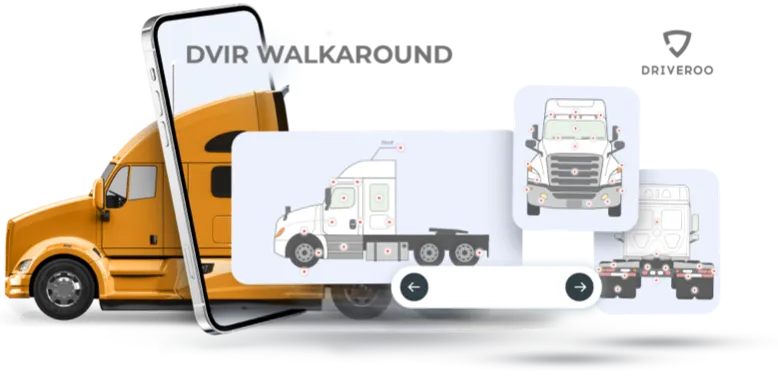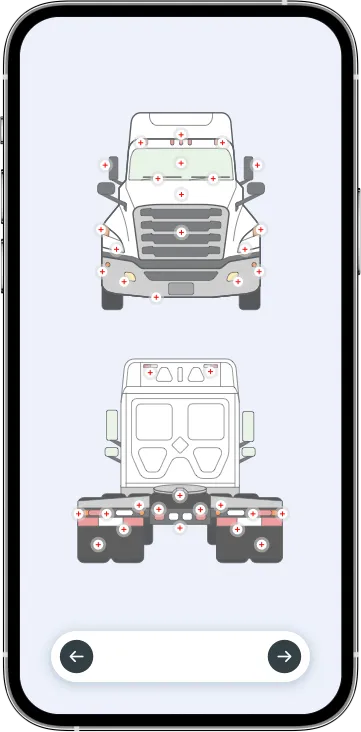Fleet Inspections
Now Easier, Faster and More Intuitive

Proper fleet inspection is crucial for several reasons:
- Safety: Regular inspections can improve fleet safety by ensuring that vehicles are in good operating condition and less likely to experience major problems on the road, which in turn keeps drivers and other motorists safe.
- Savings: Inspections can help to reduce costs by allowing fleet managers to detect and address issues before they result in a roadside breakdown, which can save money and minimize downtime.
- Reliability: Inspections extend vehicle lifespans by detecting early issues and addressing them before they result in greater problems that can lead to the early retirement of the asset.
- Compliance: Inspections help fleets maintain compliance with state and federal regulations by requiring daily driver vehicle inspection reports (DVIRs), failure to which can result in hefty fines and compulsory downtime, which can significantly impact projects and operations.
- Uptime: Regular inspections can help fleets avoid unplanned downtime by allowing them to detect and address issues before they take them by surprise.
A typical paper checklist looks like this:
Fleet Inspection Checklist
Truck
Bus
Exterior Check Walk Around
Tires
Wheels and Rims
Lights and reflectors
Windshield wipers
Mirrors
Front Bumper
Grille
Hood
Windshield
Doors
Door Glasses
Sleeper Windows
Sleeper Compartment Body
Fender
Roof
Fuel Tank
Fifth Wheel
Rear Body Panel
Reflective Tape
Rear-End Protection
Mechanical Condition
Air Compressor
Air Lines
Rear End
Exhaust
Drive Line
Front Axle
Suspension System
Coupling Devices
Muffler
Brake Accessories
Frame and Assembly
Radiator
Equipment
Fire Extinguisher
Flags/Flares/Fusees
Reflective Triangles
Spare Bulbs and Fuses
Spare Seal Beam
Forward Facing Camera
Cheater Bar
Cabin Check
Service Brakes
Defroster
Heater
Horn
Steering Mechanism
Transmission
Parking Brakes
Dashboard
Diesel Particulate Filter (DPF)
High Exhaust System Temperature
Anti-Lock Brake System
Trailer Brakes, Anti-Lock Brake System
Stop Engine
Engine Fan
Check Engine
Low Coolant Level
Transmission Service
Stability Control
Low Voltage Disconnect (LVD)
Hill Hold
Oil Pressure
Diesel Exhaust Fluid (DEF)
High Coolant Temperature
External Check Walk Around Bus
Wipers & Washers
Windshield
Left Headlights
Right Headlights
Left Front Turn Signal
Right Front Turn Signal
Left Front Amber Flashing light
Left Front Red Flashing light
Right Front Amber Flashing light
Right Front Red Flashing light
Crossing Arm
Front School Bus Sign
Under the Hood
Fluid leaks under bus
Loose wires
Hose connection
Belts in engine compartment
Engine Oil level
Radiator coolant level
Battery
Transmission
Unusual engine noise
Exhaust system
Clutch
Wheelchair lift
Check Inside the Bus
Horn
Fans & Defroster
Stop Arm Control (Warning Control)
Inside mirrors
Brake pedal
Emergency Exists Not Blocked and in Working Order
First Aid Kit
Cleanliness of Interior
Condition of floor
Driver's seat and belt
Interior seat belts
Parking Brake or service brake
Steering
Dashboard Lights
ABS light
Brake Pressure light
Brake Alarm
Malfunction Indicator Lamp
Stop Engine light
Engine Warn light
Diesel Exhaust Fluid (DEF) light
Brake Air Front light
Brake Air Rear light
Low Fuel Pressure light
High Coolant Temp light
Diesel Particulate Filter Lamp
Check Transmission light
Transmission Temperature light
Coolant Level light
Hydraulic Fluid Temperature light
High Exhaust System Temperature light
Low Oil Pressure light
Pre/Post-Trip DVIR
Commercial motor vehicle operators can save a lot of time and enjoy many other benefits by using Driveroo Fleet app, a modern digital Driver Vehicle Inspection Report (DVIR) software solution.
Save Time – Go Digital
Explore Driveroo digital fleet inspection
- Increased efficiency: The Driveroo Fleet inspection app streamlines the fleet inspection process, allowing drivers to quickly and easily complete inspections using a mobile device. This saves time and improves overall efficiency for both drivers and fleet managers.
- Improved safety: By identifying and addressing issues with vehicles before they become safety hazards, the Driveroo solution helps to improve overall fleet safety and reduce the risk of accidents.
- Reduced downtime: By detecting and addressing issues early on, the solution helps to reduce the risk of unexpected breakdowns and minimize downtime for vehicles.
- Increased compliance: The Driveroo solution includes customizable checklists that ensure compliance with state and federal regulations. This helps fleets to avoid costly fines and penalties for non-compliance.
- Data-driven insights: Driveroo Fleet dashboard provides detailed reports and analytics on fleet performance, allowing fleet managers to identify trends and make data-driven decisions to improve efficiency and reduce costs.

How it Works
1
The driver utilizes a mobile app to inspect the vehicle and document their findings.
3
Once the repairs
are finished, they are recorded in the original inspection report.
5
The vehicle is now ready for
the road, with a comprehensive inspection report fully compliant with regulations.
FAQ, WHAT YOU SHOULD KNOW
Who is responsible
for fleet inspections?
for fleet inspections?
The responsibility for fleet inspections typically falls on the company that owns or operates the vehicles. This may be the company's in-house maintenance team or a third-party provider specializing in fleet maintenance and inspections. In some cases, regulatory agencies may also require specific inspections or certifications to be conducted by authorized inspectors. While drivers can play a role in identifying potential issues with their vehicles, they are not typically...
responsible for conducting formal fleet inspections. It is the responsibility of the company to ensure that their vehicles are properly maintained and regularly inspected. However, drivers can help to ensure the safety and reliability of their vehicles by reporting any problems or concerns to their supervisor or maintenance team as soon as they arise.
What is the recommended
frequency for fleet inspections?
frequency for fleet inspections?
The recommended frequency for fleet inspections can vary depending on several factors, including the type of vehicles in the fleet, the nature of their use, and any regulatory requirements that may apply. Generally, fleet inspections should be conducted on a regular basis, such as every six months or annually, to ensure that the vehicles are in good working condition and meet all necessary safety and regulatory requirements. However, some vehicles may...
require more frequent inspections based on their use and the conditions they are exposed to.
In addition to regular inspections, daily driver vehicle inspection reports (DVIRs) are a critical component of fleet inspections that help fleets maintain compliance with state and federal regulations. DVIRs are completed by drivers before and after each trip and are used to identify any defects or safety issues with the vehicle. If any defects or safety issues are identified, they must be addressed before the vehicle can be operated again.
DVIRs can help fleet managers to identify and address issues with vehicles quickly, reducing the risk of accidents and breakdowns, and minimizing downtime. They also help to ensure that all vehicles in the fleet are operating safely and in compliance with applicable regulations.
Lorem ipsum dolor sit amet
Forklift Inspection Checklist Template
